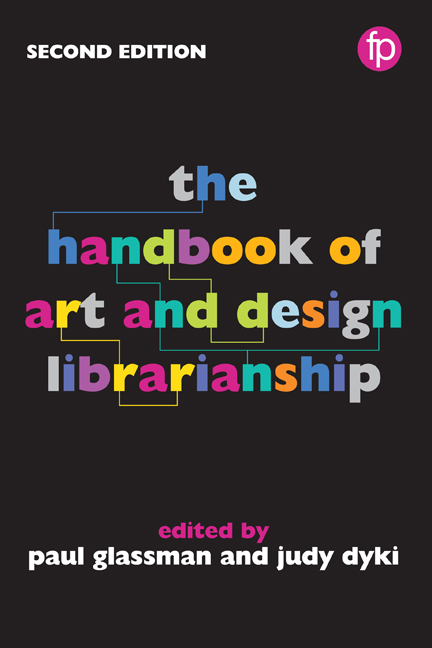Book contents
- Frontmatter
- Contents
- List of figures and tables
- Notes on contributors
- Foreword
- Preface
- Part I Roles and responsibilities
- Part II Materials and collection management
- Part III Teaching and learning
- Part IV Knowledge creation
- Part V The physical environment
- Part VI Promotion and sustainability
- Appendix Library profiles
- Index
Foreword
Published online by Cambridge University Press: 08 June 2018
- Frontmatter
- Contents
- List of figures and tables
- Notes on contributors
- Foreword
- Preface
- Part I Roles and responsibilities
- Part II Materials and collection management
- Part III Teaching and learning
- Part IV Knowledge creation
- Part V The physical environment
- Part VI Promotion and sustainability
- Appendix Library profiles
- Index
Summary
Why is there a demand for a handbook of art and design librarianship? Presumably this book is needed by what I will call ‘art librarians’ (even though this entity is made up of several species, including, notably, ‘design librarians’). Would not a handbook of librarianship be enough? Well, the success of the first edition of this work, which ran to 330 pages, suggests not.
Why might art librarians, or budding art librarians, require their own specialized handbook? Perhaps it is the ‘art’ in art librarianship that is the fly in the ointment. Libraries devoted to art, or to art and design, are inevitable, for there are, after all, libraries devoted to any subject you can imagine: maritime libraries, music libraries, zoological libraries, and there are, of course, many kinds of art libraries. Even so: why do we need specialist art librarians?
It must be that art librarians bring other skills or knowledge to libraries of art. Foremost among these qualities must be a knowledge of art and design and art history – even an inside knowledge of art.
The art librarian needs not only to speak the language of art and design but also to be able to read images and objects, to be highly visually literate. That there are such requirements for the art librarian, as well as the need to be in the swim of new ideas and techniques in library science reported in such a book as this, is testimony to the challenges and complexities of connecting hungry users with their prey.
So how might such knowledge help art librarians to engage with their users? It concerns their ability to understand the terms of reference of the users, and thereby to better interpret their needs. Some users of art libraries will have far-out preoccupations; if so, one's attempts at connecting them involve the kind of process that makes art librarianship interesting. Inevitably art librarians, like other librarians, are engaged in life-long learning.
Art librarians facilitate connections between people and art, and most of these interconnections begin at the level of sharing data. Initially the librarian and the user need to agree on the nature of an enquiry through conversation, or by interrogating images. Then the enquiry might be satisfied with surrogates for art: prose, reproductions, books of images, electronic duplicates, filmic doppelgangers and other forms of information.
- Type
- Chapter
- Information
- The Handbook of Art and Design Librarianship , pp. xvii - xviiiPublisher: FacetPrint publication year: 2017

